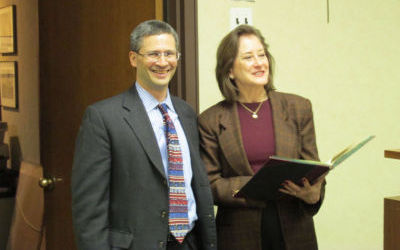Village of Great Neck Plaza Jean Celender will become Great Neck peninsula’s lone full-time mayor under a draft 2013 budget released at Wednesday’s board of trustees meeting
The proposed $5.24 million budget calls for spending to drop $1,018 from 2012 with no increase in taxes. But the budget reflects changes in how money is distributed as the village accounts for personnel changes in the new year beginning with Celender’s new status.
Under the proposed budget, Celender will formally serve as a full-time mayor in 2013 with her salary increasing from $40,000 to $65,000 per year.
“In the past I’ve been a part time mayor because I had my own business… now I don’t. I’ve asked the board to be full time, and the increase is reflected there,” Celender said. “It’s a challenging time now, and trying to continue to do projects and make infrastructure improvements and revitalize the downtown – all the challenges we face right now, it’s requiring a full-time effort.”
Celender said she had been working full-time hours since June and that the raise in salary would bring her pay to the same level received by Village of Great Neck Plaza mayors who worked full time in the past.
Former mayor Bob Rosegarten served full-time for eight years, said Celender, and Allan Gussack, who was mayor from 1982-1992, worked full time for the last few years of his term.
The Village of Great Neck Plaza is the second largest of the peninsula’s nine villages with a population of 6,900. The Village of Great Neck Plaza, where Mayor Ralph Kreitzman works part time at a salary of $10,000, has a population of 9,800. Village of East Hills Mayor Michael Koblenz, who works part time, currently has the highest salary among North Shore mayors at $60,500.
The 2013 budget plan presented Wednesday does not reflect expenses incurred in the cleanup following Hurricane Sandy.
Those costs, estimated by Celender at $75,000 to $100,000, will be included in an updated budget to be prepared in the coming weeks.
The village expects to see all its storm expenses recouped, with the Federal Emergency Management Agency covering 87.5 percent and the state paying 12.5 percent of the costs, said Celender.
But it may take time. FEMA was still doling out reimbursements from 2011’s Hurricane Irene through the end of last year.
“We do anticipate it will be a longer time,” said Clender. “Because it’s more widespread and many more villages, FEMA will be inundated.”
The village is also predicting savings as result of several town employees leaving their positions last year who have not been replaced.
The public works department is down one employee, with a savings of $21,000 projected. A parking enforcement officer also left, reducing labor costs by $46,462.
And the village’s housing commissioner retired, saving over $37,000.
Celender said the departing workers’ job responsibilities have been redistributed among remaining staff.
“Everyone’s working smarter and harder,” she said.



